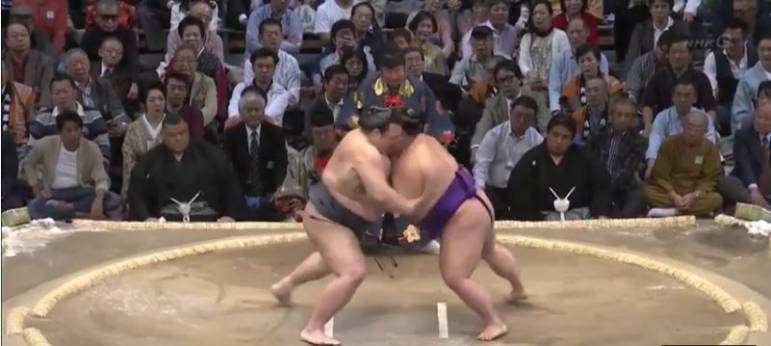
For anyone new to Sumo wrestling, here’s a brief glossary of some Japanese terms used in the sport.
Ranks and Titles
Rikishi – A sumo wrestler.
Makuuchi – (lit. – inside the curtain) – The highest level of sumo wrestling, fixed at 42 rikishi. It comes from an earlier era where the elite rikishi were allowed to wait behind a curtain separate from everyone else prior to their bouts.
Yokozuna – (lit. – horizontal rope) The highest rank in sumo wrestling, the term comes from the rope-like belt known as a tsuna worn during ceremonies, similar to spiritual rope used in Shinto to mark off sacred space.
There have been 72 recorded yokozuna since the beginning of modern sumo in the 18th century. Today, to become a yokozuna, a rikishi generally needs to win two tournaments in a row or win one tournament and finish second in two of their last three. They also must have sufficient hinkaku, or “dignity.” Hinkaku is highly subjective and determined by the Japan Sumo Association.
If a yokozuna has a make-koshi, or losing record, in a tournament, they are expected to retire as the concept of a yokozuna represents the pinnacle of the sport and anything outside of excellence is considered unbecoming of some one at that level. However, it has become common practice for yokozuna to withdraw from tournaments due to injury before the end of tournaments, particularly when they feel a losing record is imminent.
Ozeki – Technically the second highest rank in sumo, as yokozuna are officially just ozeki with special privileges and responsibilities.
To become an ozeki, a rikishi generally needs to win 33 matches in their previous three tournaments, although slightly fewer than 33 is acceptable if they win a tournament outright or receive awards for their technical skill or fighting spirit.
An ozeki can be demoted to sekiwake for two consecutive make-koshi, but they cannot be demoted below sekiwake.
Sekiwake – There are at least two and no more than four sekiwake at all times and it generally takes 33 wins over the last three tournaments for a sekiwake to be promoted to ozeki. A make-koshi will generally see a sekiwake demoted if there is a komisubi ready to replace him.
Komisubi – (lit – little knot) The lowest rank in the sanyaku, or upper ranks of the makuuchi. It takes 11 wins and an open sekiwake spot to ensure promotion while a make-koshi. As with the sekiwake rank, there are always between two and four komisubi, and a make-koshi generally means demotion.
Maegashira – The lowest rank within the makuuchi, there are numbered rankings within the Maegashira as well (i.e – Maegashira #1, Maegashira #2, etc.), and each numbered ranking has two rikishi: an “east” rikishi and a “west” rikishi. The “east” rikishi is considered slightly better than the west.
Maegashira are promoted with a kachi-koshi, or winning record in a tournament, and are demoted after a make-koshi. The top maegashira can become a komisubi with a kachi-koshi if a komisubi has a make-koshi or there are fewer than four komisubi.
Juryo – (lit. – ten ryo) – The level just below makuuchi, occasionally juryo rikishi will fight at the makuuchi level for a day if a rikishi unexpectedly leaves the tournament due to injury. Like the maegashira, they move up and down the rankings depending whether they have a winning record or losing record.
The term comes from what was once the set salary for rikishi at their rank.
Kimarite (finishing moves)
These are 87 official kimarite, or finishing moves. Here are some of the most common ones.
Hatakikomi – (lit. – slap down) – when a rikishi slaps their opponent on the upper back, shoulder or arm from behind in a downward motion.
Hikiotomi – (lit – downard pull down) similar to a hatakikomi, but involving a pull rather than a push.
Oshidashi – When a rikishi pushes another rikishi out of the dohyo, or ring.
Oshitaoshi – Similiar to a oshidashi, pushing the rikishi out of the dohyo, but with a downward slapping motion.
Tsukiotoshi – Thrusting down the opponent by a push to the back.
Sukuinage – A throw where the rikishi reaches around the other rikishi’s back and turns sideways, twisting the defender around and onto his back.
Uwatenage – A move where the attacking rikishi locks their opponent’s arm to grab the mawashi in order to throw them to the ground.
Yorikiri – The same as an oshidashi, only with the winning rikishi grabbing the opponent’s mawashi, or belt, while pushing them.
Other Terms
Basho – (lit. – place) – term for a tournament. There are six a year, occurring in odd numbered months
Kachi-koshi/Make-koshi – Winning record and losing record. This occurs when a rikishi recieves eight wins or losses and is generally critical when it comes to promotion or demotion in rank.
Kinboshi – (lit. – gold star) – whenever a maegashira defeats a yokozuna. The maegashira receives a bonus for that win and every win for the rest of their career.
Mono-ii – (lit. A talk about things) – A review by judges to confirm or overturn the referee’s decision.
Gyoji – The referee.
Tachi-Ai – The initial contact at the beginning of a bout. Comparable to contact between offensive and defensive linemen in American football.
Yusho – first place at the end of a basho.







